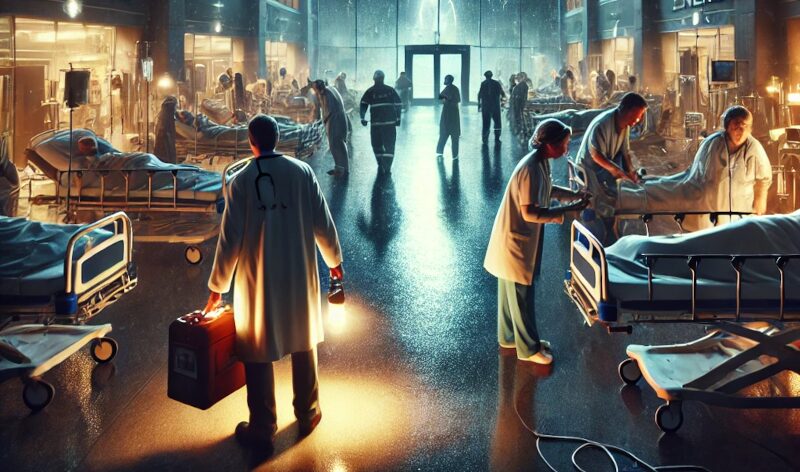The Energy Emergency Threatening US Hospitals
Hospitals are meant to be safe havens, the places people turn to in times of crisis. But what happens when the hospitals themselves are in crisis?
The U.S. healthcare system is facing an energy emergency, and it’s one that could cost lives. The increasing frequency of extreme weather events, combined with an aging power grid, has left hospitals vulnerable to power failures.
For a facility where even a momentary loss of power can mean the difference between life and death, this is an unacceptable risk.
A System on the Brink
The U.S. power grid is decades out of date, and hospitals are feeling the consequences.
The Texas winter storm of 2021 was a wake-up call.
As temperatures plummeted to record lows, the state’s fragile grid collapsed under the demand for electricity, leaving millions without power for days.

Hospitals across Texas were thrown into emergency mode. Water pipes burst, ICU equipment failed, and hospitals struggled to keep power flowing to life-support machines. Some hospitals had to evacuate patients, while others ran out of critical supplies such as oxygen and heating fuel.
In one particularly devastating case, St. David’s South Austin Medical Center lost access to running water, leaving staff to manually transport water buckets to patient rooms just to flush toilets.
This was not just a crisis—it was a failure of infrastructure that put countless lives at risk.
According to the U.S. Department of Health and Human Services (HHS), climate-induced power failures are becoming an increasing threat to hospital infrastructure.
Floods, hurricanes, wildfires, and heatwaves have all led to major power disruptions in healthcare facilities across the country.
Hurricane Ian in 2022 provided another grim example.
The Category 4 storm made landfall in Florida, causing catastrophic flooding and power outages that lasted for weeks. Hospitals in the hardest-hit areas found themselves running solely on backup generators, with limited fuel supplies.
Some hospitals, such as HCA Florida Fawcett Hospital in Port Charlotte, suffered roof damage that allowed floodwaters to pour into the ICU, forcing staff to move critically ill patients upstairs while working in complete darkness.
Many hospitals lost communication with emergency services due to cell tower failures, complicating rescue efforts. Without reliable power, even the best-equipped hospitals were left vulnerable.
In California, wildfires have emerged as a persistent and growing threat. Power companies, attempting to prevent electrical lines from sparking fires, have initiated planned blackouts that have left hospitals scrambling for backup power.
In 2019, Sutter Health’s Alta Bates Summit Medical Center was forced to cancel surgeries and transfer patients as a planned blackout left them relying entirely on emergency generators. The unpredictability of these outages means that even when hospitals plan for disasters, they can still be caught off guard, highlighting the urgent need for energy independence in healthcare facilities.
The Cost of Power Failures in Healthcare
A single power outage in a hospital can have catastrophic consequences. Medical equipment fails. Surgeries have to be delayed or canceled. Patients in critical condition are put at even greater risk.
And these failures come with a massive price tag.
A study by the American Hospital Association found that hospital power outages cost the U.S. healthcare system hundreds of millions of dollars annually, between lost revenue, emergency repairs, and increased patient mortality rates.
Hospitals rely on backup generators, but these systems are far from foolproof. Diesel generators, the most common form of backup power, require regular maintenance and fuel supplies that can be disrupted in a crisis.
During Hurricane Katrina in 2005, this weakness became painfully clear.
Hospitals across New Orleans lost power as the city flooded, and many backup generators, located in basements, were submerged and rendered useless.

As fuel supplies dwindled, even functioning generators failed, leaving hospitals in darkness.
One of the most infamous examples was Memorial Medical Center, where staff were forced to make life-or-death decisions about which patients to evacuate and which to leave behind. Without electricity, ventilators and life-support machines shut down.
The heat inside the hospital soared to unbearable levels. Some patients died because there simply weren’t enough resources to save them.
In total, 45 bodies were recovered from the hospital in the days following the storm, leading to an investigation into whether doctors and nurses were forced to hasten deaths due to the lack of resources.
The devastation at Memorial Medical Center highlighted a stark reality—hospitals were never designed to operate in prolonged energy crises.
Many hospitals at the time had backup generators, but they were not prepared for the prolonged outages caused by Katrina’s destruction. Fuel deliveries couldn’t get through the flooded streets, and no centralized emergency energy plan was in place to handle a widespread disaster of this magnitude.
This catastrophe underscored the urgent need for hospitals to rethink their reliance on traditional fossil fuel-based backup systems and look for more sustainable, resilient energy alternatives.
Renewable Energy as a Lifeline
Some hospitals are waking up to the reality that relying on the traditional power grid is no longer an option. Instead, they are turning to renewable energy solutions, particularly solar power and microgrids, to ensure they can keep running when disaster strikes.
Valley Children’s Hospital in California is a prime example. The hospital is investing in a solar microgrid that will provide 80% of its electricity, significantly reducing its dependence on the grid. The project, expected to save the hospital $15 million over the next 25 years, also ensures that life-saving equipment will continue running even if the surrounding area loses power.
Kaiser Permanente, one of the largest healthcare providers in the U.S., has already installed over 100 megawatts of on-site solar power across its facilities. The organization has committed to achieving carbon neutrality, not just to reduce emissions but to strengthen its energy security.
The Future of Hospital Energy Security
Renewable energy isn’t just about cutting costs or reducing carbon footprints—it’s about survival.
Hospitals must rethink their energy strategies if they want to avoid future disasters. Investing in solar microgrids, battery storage, and other renewable technologies isn’t just a good idea; it’s a necessity.
Policymakers also need to step up.
Federal and state incentives can accelerate the adoption of renewable energy in healthcare, ensuring that hospitals have access to the funding and resources they need to implement these solutions.
Grants, tax credits, and infrastructure funding should prioritize hospitals, which serve as critical lifelines in emergencies.
The bottom line is clear: hospitals can no longer afford to rely solely on a fragile, outdated power grid. The technology exists to protect them, and the financial incentives are there. The only question is how many more disasters it will take before the entire healthcare system embraces energy resilience as a top priority.




